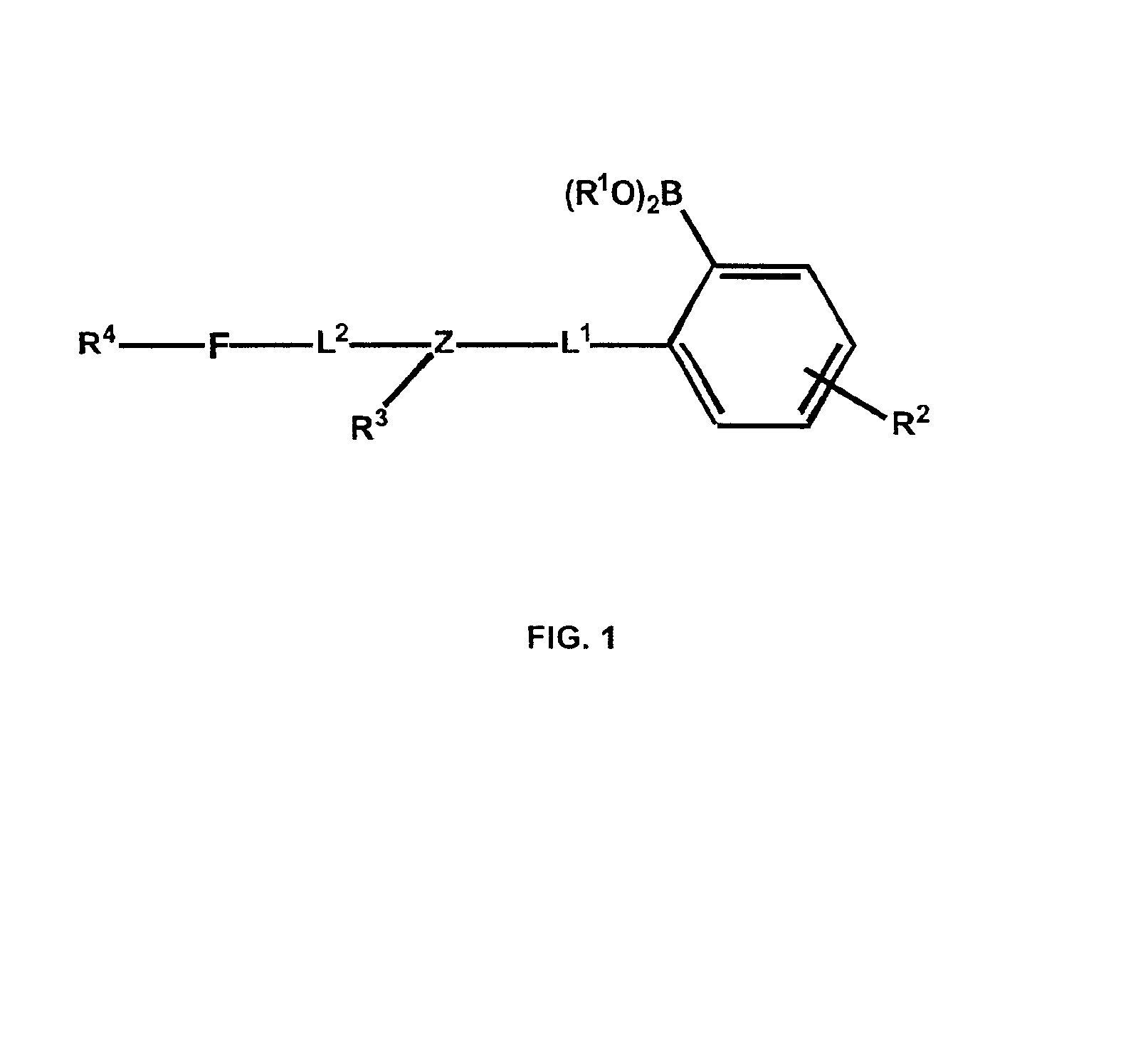Polymers functionalized with fluorescent boronate motifs and methods for making them
a technology of fluorescent boronate and polymer, applied in the field of biological sensors, to achieve the effect of enhancing the solubility biocompatibility and/or the hydrophilicity of the polymer composition, and swellability
- Summary
- Abstract
- Description
- Claims
- Application Information
AI Technical Summary
Benefits of technology
Problems solved by technology
Method used
Image
Examples
example 1
Illustrative Polymer Synthesis & FBA Incorporation
[0126]Disclosed herein is the design and implementation of a carboxylate polymer with a covalently bound boronate fluorophore conjugate capable of binding and signaling the amount of glucose under aqueous physiologically relevant conditions. Within the class of carboxylate containing polymers, one example would be that of a carboxylated polystyrene. The AB(CH)5—OH is only of a variety of glucose binding and signaling species that might be attached through the carboxylates on the polystyrene. FIG. 8 illustrates the formation of this polymer and the subsequent attachment of the fluorescing glucose reporting species.
Polymer Synthesis & FBA Incorpotation
[0127]Given the successful demonstration of glucose sensing, in vitro, with poly(4-carboxystyrene)-anthracene boronic acid (FIG. 12A), the choices of polymer for the next generation of sensor material are quite meaningful and rational. The primary approach uses a styrenic copolymer as the...
example 2
Illustrative Protocol for the Incorporation of Pentylhydroxy AB into Carboxypolystyrene
[0133]Carboxypolysyrene. A 10-mL, one-necked teat drop shaped flask equipped with a stirring bar, a reflux condenser, and a nitrogen inlet adaptor was charged with 4-vinylbenzoic acid (0.296 g, 2.00 mmol), AIBN (0.000548 mol; 0.100 mL of stock 0.0248-mmol solution made by dissolving 4.50 mg AIBN in 10 mL THF; 0.000137 equiv), and 3 mL THF. The clear, colorless solution was heated to reflux for 24 h-36 h, at which point most of the solvent had evaporated and the reaction contained a light yellow solid. This polymeric material is insoluble in THF, and forms a gel-like substance in a mixture of THF-DMF.
[0134]Incorporation of pentylhydroxy AB. After washing to remove any traces of the initiator, the polymer is suspended in THF and DMF (1:1; 2 mL each), and charged with TEA (0.300 ml; 2.14 mmol; 2.14 equiv compared to the number of carboxylates present), DMAP (8.00 mg; 0.0655 mmol; 0.033 equiv), EDAC (...
example 3
Standard Method of Obtaining Transductions in Films
[0136]Films ate either stuffed in a quartz microcuvette with a 0.75 mL capacity, or fixed between a pair of half opened paper clips or in a mesh (simply used to hold the film steady and uptight) in a disposable polyacrylate cuvette. After obtaining a steady baseline (important for films), glucose is added as a “spike” usually of 0.100 mL of stock 5000 mg / dL stock solution. This gives a final ca 125 mg / dL-165 mg / dL glucose concentration depending on the volume of solution in the disposable cuvette. It is slightly mote challenging to determine the amount of glucose in the quartz microcuvette since the volumes ate more difficult to measure and the additions are more difficult to make. For example, an addition of 0.050 mL of 5000 mg / dL gives a 333 mg / dL glucose spike assuming a total volume of 0.75 mL. The total volume is difficult to estimate since the film occupies some of the space as well. In almost all cases at present, the mesh me...
PUM
| Property | Measurement | Unit |
|---|---|---|
| emission wavelengths | aaaaa | aaaaa |
| emission wavelengths | aaaaa | aaaaa |
| emission wavelengths | aaaaa | aaaaa |
Abstract
Description
Claims
Application Information
 Login to View More
Login to View More - R&D
- Intellectual Property
- Life Sciences
- Materials
- Tech Scout
- Unparalleled Data Quality
- Higher Quality Content
- 60% Fewer Hallucinations
Browse by: Latest US Patents, China's latest patents, Technical Efficacy Thesaurus, Application Domain, Technology Topic, Popular Technical Reports.
© 2025 PatSnap. All rights reserved.Legal|Privacy policy|Modern Slavery Act Transparency Statement|Sitemap|About US| Contact US: help@patsnap.com



